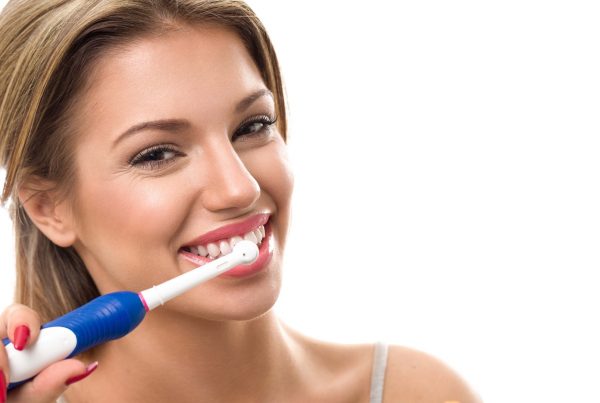Your child’s dental development (from 0 to 18 years old)
As a general rule, we should all have 2 sets of teeth; 20 baby teeth (also called milk teeth) and 32 adult teeth (also called permanent teeth). Your child’s baby teeth come through between the age of 6 months and 3 years. This is called teething. However, it is not unusual for some babies to be born with teeth.
Around the age of 6 or 7 years old, the first adult teeth will start to come through. The first adult teeth are often molar teeth that come through behind all of the baby teeth, without any of the baby teeth falling out. At roughly the same time, the first baby front teeth will fall out and be replaced with adult incisor teeth.
Around the age of 10 to 12 years old, the remaining baby teeth fall out in quick succession and are replaced with a mouth full of big, strong, permanent, adult teeth. Your child will also get some extra molar teeth at this time. The final teeth to erupt (wisdom teeth) will not generally appear until late teens, early twenties or perhaps even later.
The picture below describes average ages that each tooth erupts in great detail if you are interested. If you are not interested, don’t worry; there isn’t a test.
0-3 years old
20 baby teeth come through into the mouth. By the age of 3, all baby teeth will usually have erupted.
6 years old
The first adult teeth come through. These are adult molar teeth that erupt behind the baby teeth. No baby teeth are lost at this point.
6-8 years old
8 baby incisor teeth fall out and are replaced by permanent, adult incisor teeth. Because your child is still so young, the adult front teeth may appear quite big at this age.
10-12 years old
Loads of baby teeth fall out on quick succession and are replaced by permanent teeth. There are usually no baby teeth remaining after this age.
12 years old
More adult teeth come through right at the back of the mouth.
18-25 years old
Wisdom teeth come through around this age. (That’s if you have them. Lots of people don’t.)
The Importance of Baby teeth
Baby teeth are vital for guiding your child’s dental development. If they are lost early because of tooth decay, this can lead to crowding which may result in complex treatment with braces in future. Infections of baby teeth can also cause abnormalities in the adult teeth developing underneath. Time off school, altered sleep and eating patterns and low self-esteem can all be consequences of rotten baby teeth.
Patterns and behaviour in the first years of your child’s life will often continue. If habits like not brushing teeth and eating sugary foods cause decay in baby teeth, your child may get holes in their adult teeth too.
Teething
Teething begins around the age of 3-6 months.
Signs of teething:
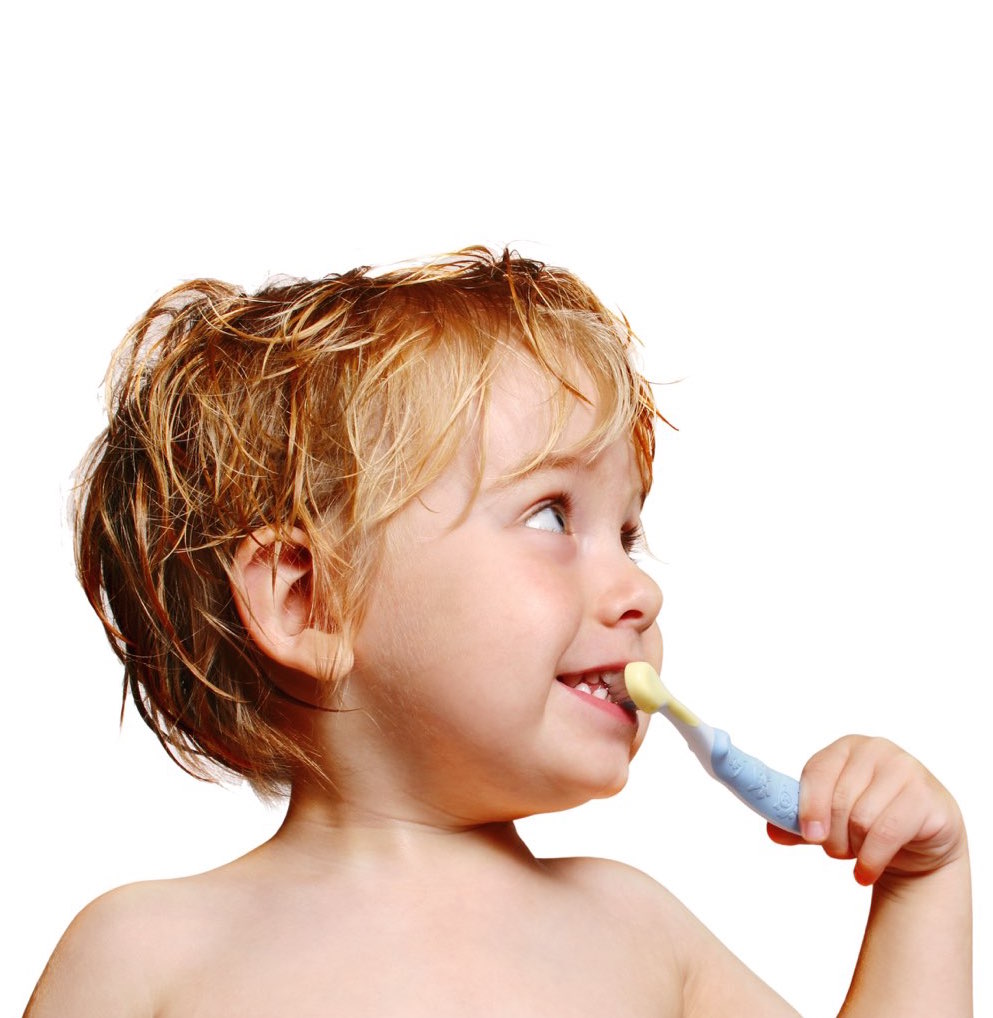
Dribbling more than usual
Sore, red gums
Flushed cheeks
Restless, disturbed sleep patterns
Loss of appetite
Chewing on anything and everything
To help with teething, cuddles and comfort will calm your baby. It may help to lightly massage the gums with a clean finger or dry toothbrush.
Teething rings cooled in the fridge can help ease the discomfort.
Please consult your pharmacist if you intend to use a teething gel or infant paracetamol for teething babies. Currently, these products are free if you are registered for Minor Aliments at your pharmacy.
Caring for your child’s teeth
Register your baby with a dentist by 6 months or as soon as the first tooth appears. Your baby should visit the dentist at least once by the time they are 1 year old. Often bringing your baby along to their siblings dental appointments can help get them used to the environment from an early stage.
Tooth decay is caused by sugar, bacteria, time and a susceptible tooth. To prevent tooth decay, it is important to brush twice daily using an age appropriate fluoride toothpaste and reduce your child’s sugar intake.
Tooth decay
Tooth decay (cavities) is caused by sugar, bacteria, time and a susceptible tooth.
Everyone’s mouth contains plaque, a soft build up of bacteria. When plaque is exposed to sugars in foods and drinks, the bacteria produce acids. These acids damage teeth by dissolving the tooth surface.
When sugary foods and drinks are consumed frequently, acids are produced more often and damage is caused to teeth. Foods and drinks containing sugar should be kept to a minimum and are best given at mealtimes.
There are lots of useful tools available to help you choose tooth friendly snacks and treats.
The food scanner app available via www.nhs.co.uk/change4life helps to make positive food choices for your child and reduce the amount of sugar in their diet.
Nursing bottle decay
Nursing bottle decay occurs with prolonged, on demand breastfeeding or bottle-feeding often at nighttime. The top front baby teeth and baby molars are often affected by cavities which, if left untreated, may result in their removal.
It is therefore important to always brush your babies teeth with an age appropriate fluoride toothpaste after their evening feed. Watering down milk in the bottle is a useful way to reduce the amount of harmful milk sugars overnight. Your child should be encouraged to drink from a sippy cup over the age of 6 months and try to avoid using a bottle over 1 year of age.
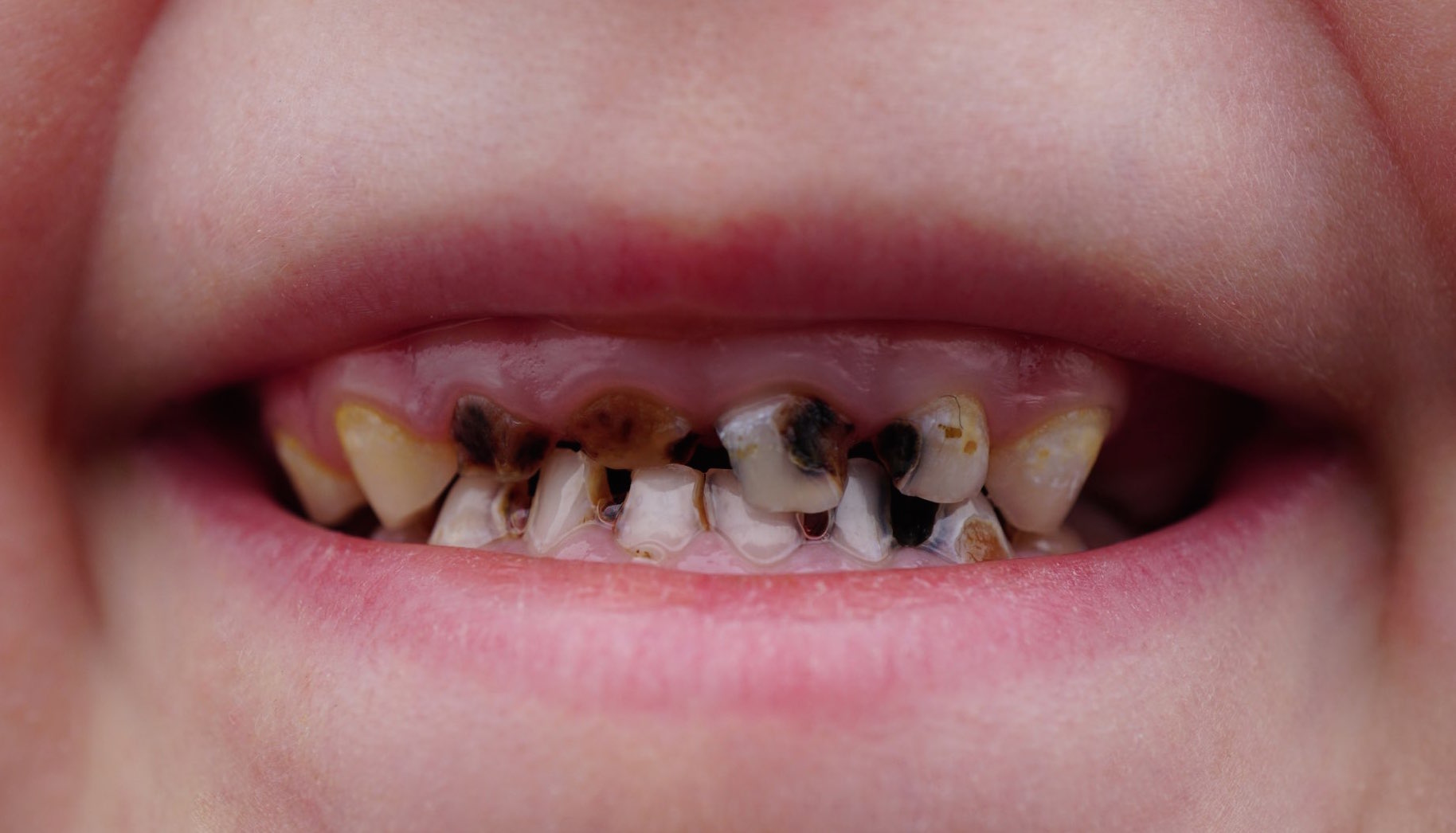
Toothbrushing
As soon as your child’s first tooth comes through around the age of 6 months, you need to start toothbrushing twice a day with a toothbrush and toothpaste. Toothbrushing should be done last thing at night and at least one other time during the day.
Use a child-sized toothbrush with a small, flat head and soft or medium bristles.
Children can brush their own teeth but a parent or guardian must also brush their teeth until at least the age of 8 years old to ensure a thorough clean.
When brushing, position yourself behind your child.
Children can use an electric toothbrush from whenever they can tolerate it.
Replace your child’s toothbrush once the bristles start splaying apart, generally every 3-4 months.
Toothpaste and Fluoride
Toothpaste must contain fluoride. Fluoride acts to harden and protect teeth. This is particularly important for children as new teeth are softer when they first come through. The amount of fluoride that should be in a child’s toothpaste varies depending on their age. Take a look at the table for advice on how much fluoride should be in your child’s toothpaste and how much to use.
Current Advice from the Department of Health

Make sure that your child’s toothpaste is appropriate for their age.
Encourage your child to spit out toothpaste after brushing. Do not let your child rinse with water after brushing. This leaves a little bit of toothpaste on the teeth so that the fluoride keeps protecting them.
Try to avoid fruit flavoured pastes as these may contain sugar and not enough fluoride.
Diet and sugars
A balanced diet is extremely important when trying to avoid your child suffering from tooth decay. Sugar in foods should be kept to a minimum. There are huge amounts of sugar in fizzy drinks and sweets but did you know that there are hidden sugars in lots of things that you wouldn’t expect? Processed foods and snacks may be damaging your child’s teeth without you realising.
Sugar attacks
You will already know most of the foods and drinks that contain lots of sugar.
• Sweets and chocolates
• Fizzy drinks and juices
• Flavoured yoghurts
• Breakfast cereals
Sugar can be hidden in foods like pasta sauces, cereal bars, dried fruits and raisins so always read the label.
Sugary snacks should be avoided as much as possible and kept to meal times. If children have sugary foods throughout the day, their teeth are under attack all of the time by sugars. This causes tooth decay to grow rapidly.
Healthy snacks
If your child needs a snack between meal times, try one of these healthy alternatives.
• Toast
• Oatcakes
• Cheese
• Fruit
• NaturalYoghurt
• Carrot sticks or cucumber
Remember fruit juices and smoothies contain a lot of sugar. Fruits should be consumed whole rather then being juiced, squeezed or blended.
Drinks
The only drink your child should have between meals is milk or water. Fizzy drinks and squash should be avoided and only allowed at meal times.
A child should never go to bed with a bottle containing a sugary drink. Parents should avoid adding honey or sugar to milk in their bottle. A child should be given water in their bottle.
Visiting the dentist;
When to start and how frequently
You may not be able to see any teeth when your child is born but they have already started growing.
You should register your child with a dentist as soon as the baby teeth start to come through. Your child should be seen by a dentist in the first year of their life and then every 6 months after that.
Bring children along with you to the dentist to get them used to seeing the dentist and the dental team.
All NHS Dental treatment is free for children up to and including the age of 17 in England.
Dental Treatments common for children
Fluoride Varnish
Fluoride is brilliant at strengthening new teeth. Public Health England recommends that dentists apply a high fluoride gel (known as fluoride varnish) to all children’s teeth twice a year as part of their check up.
Fissure sealants
A Fissure sealant does what it says on the tin. It seals the fissures of teeth to make it easier to keep them clean.
Back, molar teeth are made up of cusps and fissures. A cusp is the pointy bit that is like a little mountain. Between these mountains are little valleys. These are what we call the fissures.
Fissures between the cusps on back teeth can be quite deep, sometimes so deep that it is impossible to keep bugs and bacteria out of them. This will commonly lead to decay because you just can’t keep it clean as the bristles of a toothbrush cannot reach. In situations where the fissures are too deep to keep clean or maybe when your child has previously been at risk of decay, it can be helpful to seal the fissures. This makes cleaning easier and keeps bugs out.
The treatment is very quick and simple with no discomfort for your child. The tooth is cleaned and then sealed.
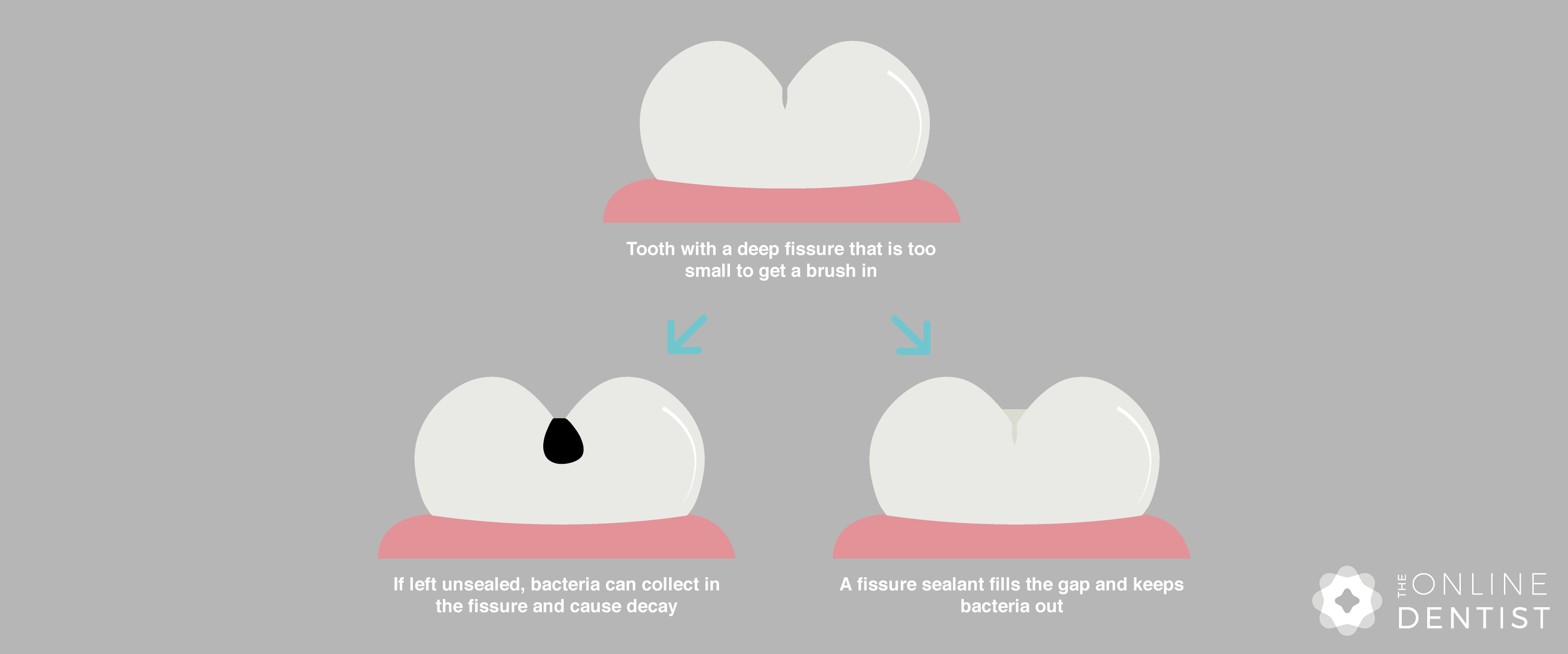
Fillings and preformed metal crowns
If your child develops tooth decay, it might be possible to treat the teeth with fillings or preformed metal crowns. Regular appointments with your dentist mean that decay can be caught earlier and teeth can be saved using these techniques. Irregular attendance at the dentist means it is more likely that your child will have to have teeth extracted if they develop tooth decay.
Extractions and General Anaesthetic
Did you know that tooth decay is the single biggest reason that children are admitted to hospital in the UK?
Thousands upon thousands of children are put to sleep to have broken, decayed, infected teeth extracted. It is not a pleasant experience for anyone involved.
This is the whole reason that we have created this information for you. We want to help you and make sure that your child do not have to go through this.
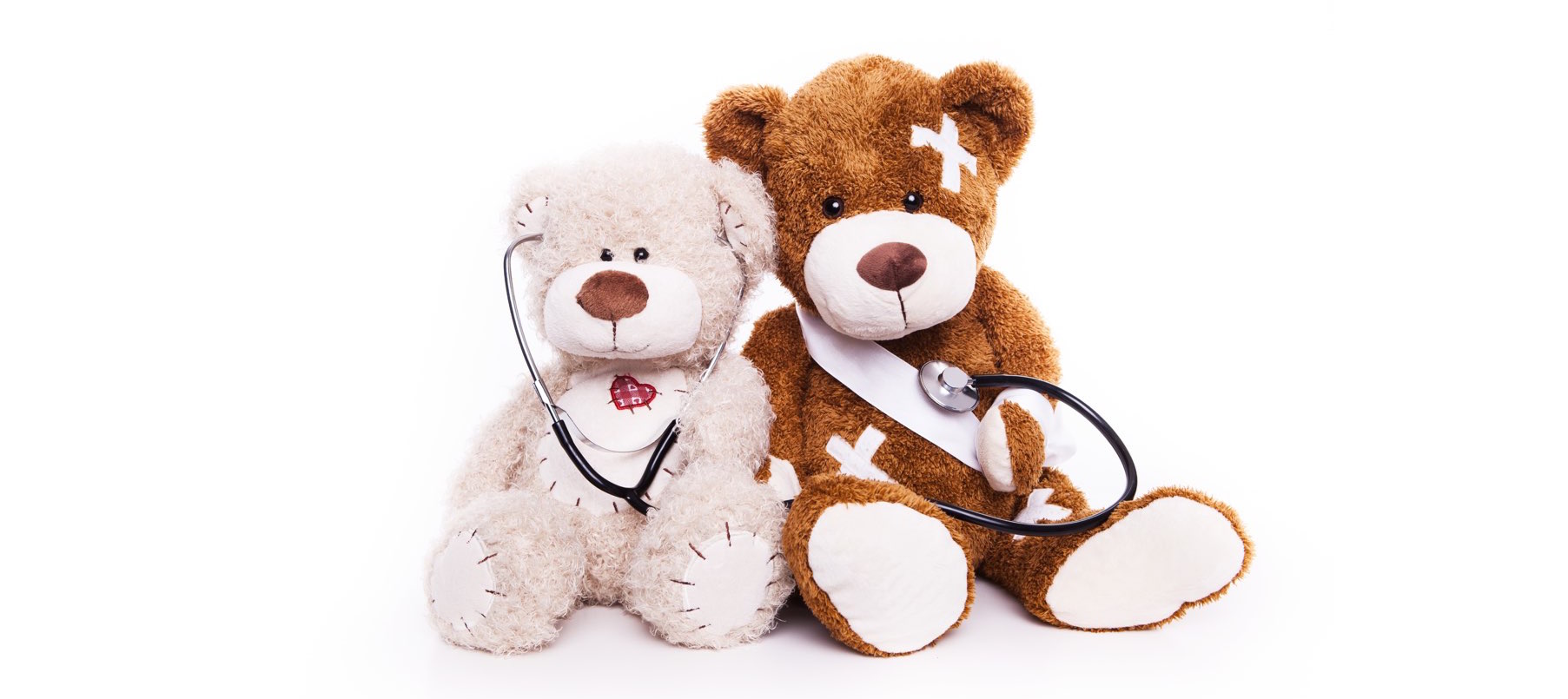
Orthodontic Treatment (Braces)
‘Orthodontic’ means ‘straight teeth’. So the idea of orthodontic treatment is to get the teeth straight and get rid of crowding and overlap by using some sort of brace. This can be done to improve chewing and improve the appearance of your child’s smile.
For the majority of children who require braces, the best time to have treatment is when all of the baby teeth have fallen out. This is generally between the ages of 12 and 16 however this will vary depending on the individual. Ask your dentist about whether your child may benefit from orthodontic treatment.
There are lots of different types of braces. The ‘train track’ style, metal braces are the most common. There are also braces that you can take out. The downsides with these are that if your child doesn’t wear their brace, the teeth will not straighten.
Often, teenagers require teeth to be removed for braces. The reason for this is to create the space required to move the teeth and get a stable end result. It’s something to be aware of if you think that your child may benefit from braces.

About the Authors
Dr Poonam Anand BDS MSc
I graduated from the University of Sheffield in 2010. I have worked as a general dentist in Leeds, Keighley and Birmingham. I completed a Masters in Dental Public Health with distinction from the University of Leeds in 2016. I have always had a passion for preventative dentistry and firmly stand by the motto ‘prevention is better than the cure’. I am keen to educate parents and improve the oral health of children.
Dr Andrew Wilson BDS
I am the creator of The Online Dentist. My work with The Online Dentist has been featured on BBC Breakfast, ITV news and BBC Radio 5 Live. I have won multiple awards, including National Young Dentist of the Year at the Dental Awards 2018. I practise as a dentist in Central London.
Keep updated with the Online Dentist newslettersign up today
Recent Articles
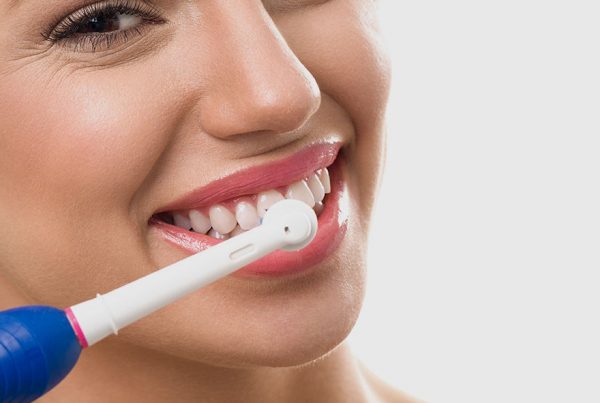 Tooth brushing is the best way we have to remove bacteria from our mouths. The majority of problems with your teeth are caused by bacteria. Bacteria making holes. Bacteria damaging...
Tooth brushing is the best way we have to remove bacteria from our mouths. The majority of problems with your teeth are caused by bacteria. Bacteria making holes. Bacteria damaging...
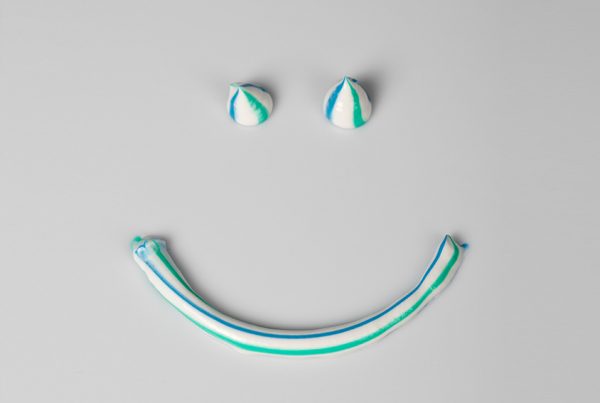 This article is all about toothpaste, what should be in it and why you should use it when brushing your teeth. Forgive me but I'm going to start out with...
This article is all about toothpaste, what should be in it and why you should use it when brushing your teeth. Forgive me but I'm going to start out with...


